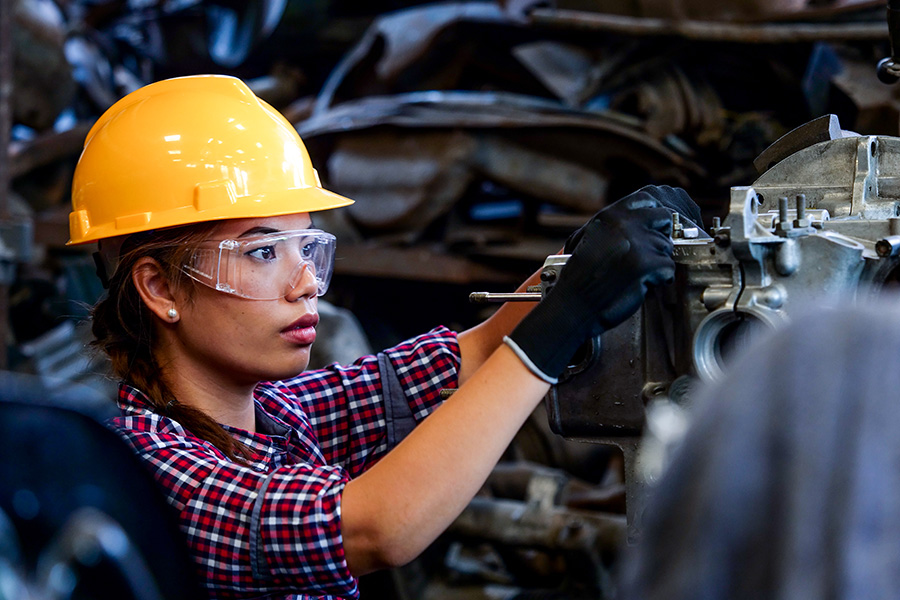
Constructive steps towards Indigenizing professional engineering
Engineers frequently deal with practical problems. But how well are engineering schools preparing them for situations where cultural differences can make or break a project? As Kaella-Marie Earle (B. Chem. Eng. 2020, Laurentian University), a newly minted Indigenous engineer in training, put it to me:
You look at mining companies, or any natural resource extraction … and one of the primary types of conflicts that they have is with Indigenous people. That is happening because there is this massive cultural and knowledge gap between the science people and Indigenous people. In engineering, we would hugely benefit from a class on treaties. Because no matter where you go, you’re going to deal with project management that has to do with Indigenous land, or Indigenous people, or Indigenous treaties.
Indigenizing post-secondary education (PSE) can sound abstract. But it is essentially about making all students more conscious of Canada’s Indigenous realities which, in turn, better prepares students for the real world.
This past year I’ve had the privilege of learning from students and academics who are leading the way in Indigenizing PSE in Canada. The Canadian Indigenous Science and Engineering Society—popularly known as .caISES—is a small, dynamic collective of people working on a tangible, practical agenda to Indigenize engineering schools, which help to define the profession. .caISES is learning from colleagues across Canada and from other countries with Indigenous populations, including the U.S. and New Zealand.
Listening to members of .caISES speak at their annual gathering in Saskatoon in March 2020, I saw a coalition in development. This is a promising sign. Students, professors, student service providers, engineering educators, and professional engineering regulatory bodies all need to work together if Indigenization is going to lead to better-trained engineers in Canada.
Randy Herrmann, Director of the Engineering Access Program at the University of Manitoba and a leading proponent of this movement, sees two parallel goals. One is to build a space where Indigenous students can be comfortable in engineering studies. The other is to introduce all Canadian engineers to Indigenous perspectives, so they understand the world better and can make engineering safer for all the people they work with.
There is a lot going on already. The Canadian Engineering Education Association recently surveyed 28 accredited engineering schools across Canada and found 11 different types of initiatives that are Indigenizing engineering education in Canadian universities.
Inclusion. Randy’s program is one of seven access programs supporting the inclusion of Indigenous students in Canadian engineering schools. Access and retention programs, such as those at Queen’s and the Universities of Manitoba and Saskatchewan, are helping Indigenous students from disadvantaged schools upgrade to meet the entry requirements of engineering faculties. Access programs also work with the university to expand how the institution admits, teaches, and evaluates students.
Reconciliation. Jannik Eikenaar, Equity, Diversity, and Inclusion Advisor at the University of British Columbia’s School of Engineering, sees the potential to introduce at least two different courses into engineering curricula to help all students and staff appreciate Indigenous perspectives. One would focus on Indigenous design principles. A great example is the design of the birch bark canoe as a uniquely Indigenous response to cross-Canada transport challenges. Manitoba Aerospace, the University of Manitoba, and Engineers Canada have created school materials on this subject that could be built upon for higher education. Another course would teach community relations for engineers, with a focus on engaging with Indigenous communities—an essential step for designing and implementing any large-scale infrastructure project in Canada today.
Decolonization. Advancing decolonization involves updating engineering curricula. Deans of engineering schools are responsible for the programs of study that produce future engineers, but they take direction from the associations of professional engineers. At the national level, Engineers Canada sees Indigenizing the engineering field as integral to building a sustainable profession that is fed by a diverse pool of qualified students. Engineers Canada manages the Canadian Engineering Accreditation Board, which sets the standards that guide the 44 Canadian universities that have engineering programs. If these standards are updated to reflect the values of Indigenization and reconciliation, they can help influence all engineering schools.
It’s all a work in progress, and depends heavily on people and institutions working together. As one Indigenous engineering professor told me, Indigenous engineers and educators are extending “a heartfelt invitation to non-Indigenous folks in this space to come join us. Because this work has to be done collaboratively with existing leaders, existing faculty, existing staff, existing administration, if it’s going to succeed and be sustainable.”
They look forward to a day when engineering studies is an ethical space where “Indigenous and Western knowledges, perspectives, principles, and values can co-exist.” And we look forward to a day when the engineers who build our national infrastructure will be better prepared to work with the Indigenous communities on whose lands those projects will stand.


Comments